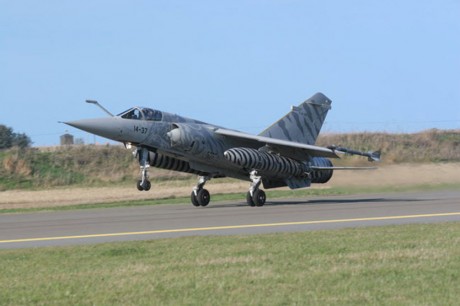Whilst the French Air Force is currently using the plane as a reconnaissance and attack platform in the Mali Air War, the Spanish Air Force is about to decommission the Dassault Mirage F1.
The Chief of the Spanish Air Force Staff (JEMA), Air General Francisco Javier García Arnaiz, recently reported that this year they would “eliminate three systems,” those that already have substitutes: the C-212 Aviocar and Fokker F-27 in the SAR Service, and the Mirage F1 fighters.
In the latter case, the Eurofighter will replace it completely when it reaches the initial operational capability in the 14th Wing Air Base in Los Llanos (Albacete).
The acquisition of the French fighters by Spain in 1972 was due by the constant interference of the United States regarding the use of Spanish Air Force’s U.S. military equipment, especially in the case of the F-86 Sabre and T-33 Shooting Star jets in the conflict of Sidi Ifni (Morocco). With the acquisition of the Mirage F1, the Spanish government marked the end of dependence on diplomatic vetoes.
In 1975 a 1st batch of 15 Mirage F1 C(E) arrived to Los Llanos Air Base in Albacete. Designated C.14, the planes were assigned to 141 Squadron, the first of the newly created 14th Wing.
The F1 C was an all-weather interceptor, equipped with a Thomson-CSF Cyrano IV monopulse radar and a limited secondary ground attack capability. Initially, the aircraft was armed with two internal DEFA 553 30mm cannons and Matra R530 medium-range air-to-air missiles.
The Spanish Air Force’s Mirage F1 CE suffered modifications that allowed integration with American AIM-9 Sidewinder missiles.
In the second half of 1976 a 2nd batch of planes arrived and two years later a final 3th batch which included 6 two-seater F1 BE and 24 of the most advanced single-seat F1 EE was delivered.
The F1E had an upgraded equipment with a new computer data, Head-up Display (HUD), SAGEM-Kearfott inertial platform, digital computer updated Cyrano IV radar and a fixed refuelling probe.
With this new batch, Spanish Air Force could create the 142 Squadron. The most advanced F1EE went to the 46th Wing based in Gando, Canary Islands.
In all, Spain has acquired 91 Mirage F1. 73 units initially purchased (45 F1 CE, 22 F1 EE and 6 F1 BE) plus 5 second hand units purchased from France and 13 second hand units also purchased to Qatar.
Mid-’90s, 51 single-seaters and 4 double-seaters were upgraded to F1 M version. They had a number of improvements including intelligent 26″ HUDs with integrated radar, HOTAS system, modernized Cyrano IVM radar for accurate ground-attack capability in four different modes, Night Vision Goggles compatibility, inertial navigator Sagem ULISS 47 and AIM-9 JULI Sidewinder compatibility among others.
Image credit: NATO Tiger Association / Spanish Air Force
From August 2006, Spain dispatched three Mirage F1 M fighters to Lithuania’s First Air Base in Zokniai/Šiauliai International Airport for a 4 months deployment as part of NATO’s 10th “Air Police” patrol mission within Lithuania, Latvia, and Estonia’s territorial airspace, being scrambled twice to intercept undisclosed intruders.
Nicknamed ‘La abuela’ (Grandmother) by the Spanish pilots, the Mirage F1 has been an active member of the annual NATO Tiger Meet since 1986. From this year, the state-of-the-art Eurofighter Typhoon will take that role within the 142 Squadron.
El Lince Analista for TheAviationist.com















